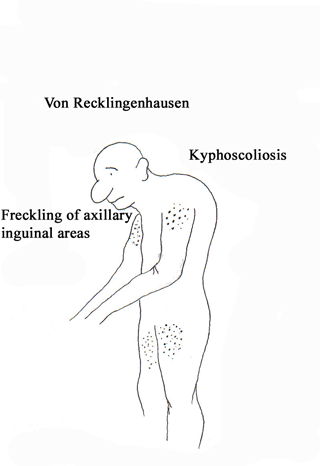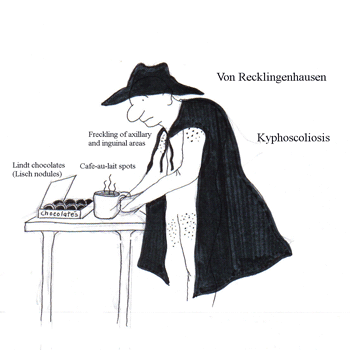VonRecklingenhausen Disease Internal Medicine
HISTORICAL INFORMATION
• 1793: Tilesius von Tilenau first described neurofibromatosis.
• 1849: R. W. Smith further described it.
• 1882: von Recklinghausen was the first person to associate the origin of this disorder to tumors
arising from cells of the nerve sheaths.
• 1880s: Joseph Carey Merrick in London known as the “elephant man” because of his disfiguring
deformity of the head, extremities, and vertebral column.
DISEASE OVERVIEW
• Type 1 neurofibromatosis (NF1, von Recklinghausen disease, peripheral neurofibromatosis) is a
multisystemic disease.
• autosomal dominant disorder; Chromosome 17 gene locus
(17 letters in VonRecklingenhausen disease)
• 1 in 4000 individuals are affected.

DIAGNOSIS (2 or more of the following criteria)
• More than 6 café-au-lait spots measuring at least 15 mm in adults and 5 mm in children
(Café-au-lait spots are found in more than 50% of individuals with NF1.)
• At least 2 or more neurofibroma of any type or at least 1 plexiform neurofibroma
• Freckling in the axillary or inguinal regions
• Optic glioma
• Two or more Lisch nodules (iris hamartomas) (VonRecklingenhausen is eating Lindt chocolates)
• A distinctive bony lesion, such as sphenoid wing dysplasia or thinning of a long bone with or
without pseudoarthrosis
• A first-degree relative with NF1, as suggested by these criteria

SIGNS
• spinal deformities: scoliosis and kyphoscoliosis.
• congenital bowing and pseudoarthrosis of the tibia and the forearm.
• overgrowth phenomenon of the extremity.
• soft tissue tumors
TREATMENT
• Plastic surgery to correct disfigurement
• Surgical treatment of intraspinal or intracranial tumors, and tumors of the peripheral nerve
- Anatomy
- Anesthesiology
- Cardiovascular Medicine
- Dermatology
- Emergency Medicine
- Endocrinology
- Gastroenterology
- Geriatric Medicine
- Gynecology
- HIV
- Hematology and Oncology
- Infectious Disease
- Internal Medicine
- Nephrology
- Neurology
- Obstetrics
- Ophthalmology
- Orthopedics
- Otolaryngology
- Pediatrics
- Pharmacology
- Prevention
- Psychiatry
- Pulmonology
- Radiology
- Rheumatology
- Surgery
- Urology
- case report
- trial reference




